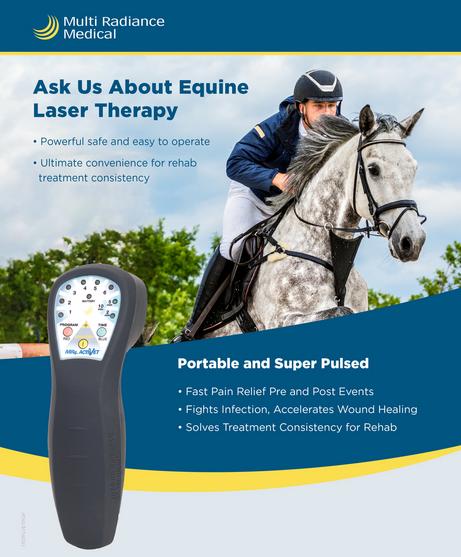Equine Therapy for Kid: Emotional and Behavior Assistance Discussed
Wiki Article
Assessing the Effectiveness of Laser Therapy in Equine Treatment for Injury Rehab
The examination of laser treatment's effectiveness in equine injury recovery rests on numerous factors, including healing time, discomfort reduction, and cells regeneration. Scientific research studies recommend noteworthy enhancements in problems like tendonitis and osteoarthritis, attributed to enhanced cellular function and elevated ATP manufacturing. Vets regularly observe superior outcomes with laser therapy contrasted to standard methods, positioning it as a crucial aspect in equine treatment. The need for continuous surveillance and tailored therapy strategies can not be overemphasized. What certain professional evidence supports these claims, and how do veterinarians execute these procedures in method?
Recognizing Laser Therapy
Laser treatment has actually come to be a crucial tool in veterinary medicine, specifically in the therapy of equine problems. Known for its non-invasive nature and efficiency, laser therapy includes the application of certain wavelengths of light to stimulate cells repair and lower inflammation. This healing modality is significantly favored for its capacity to increase the healing process in equines dealing with a selection of musculoskeletal injuries and chronic problems.The primary mechanism behind laser treatment is its capability to boost mobile functions. Furthermore, laser treatment promotes vasodilation, improving blood flow and oxygen distribution to damaged cells, thus expediting recovery.
In equine medication, laser treatment is specifically valuable for conditions such as tendonitis, osteo arthritis, and injury recovery. The method is admired for its pain-relieving residential properties, enabling steeds to regain movement and feature extra rapidly. Veterinarians also value its marginal negative effects contrasted to various other treatment techniques, making it a trusted and secure option for equine treatment.
Exactly How Laser Treatment Functions
To understand exactly how laser therapy functions, it is vital to look into the interaction in between light power and biological tissues. Laser therapy, additionally recognized as Low-Level Laser Therapy (LLLT) or photobiomodulation, uses details wavelengths of light to permeate cells and boost cellular procedures. The mechanism hinges on the absorption of photons by cell chromophores, mostly within the mitochondria, which are important for power production.Upon absorption, these photons set off a series of biochemical modifications, improving mitochondrial feature and leading to boosted adenosine triphosphate (ATP) manufacturing. This rise in ATP speeds up mobile metabolic process, promoting cells repair work and regeneration. Furthermore, laser therapy modulates inflammatory reactions by affecting cytokine levels and decreasing oxidative tension, consequently minimizing pain and swelling.
One more substantial element of laser treatment is its function in boosting microcirculation. The therapy promotes vasodilation, improving blood flow and oxygen distribution to broken tissues. This facilitates the removal of cellular debris and supports the proliferation of fibroblasts and collagen synthesis, vital for wound healing.
Scientific Proof
The efficiency of laser treatment in equine therapy has been corroborated with different scientific studies, showcasing its healing prospective across a range of problems. A research study carried out by Turner et al. (2012) demonstrated that equines treated with low-level laser treatment (LLLT) for ligament injuries exhibited sped up healing contrasted to those getting traditional therapies.Similarly, research study by Johnson and associates helpful resources (2015) concentrated on equine muscular tissue injuries, revealing that laser therapy considerably quickened muscle fiber regeneration and decreased muscle stiffness. These findings were corroborated by histological analyses showing enhanced muscle mass tissue organization. Professional evaluations have shown that laser treatment can relieve persistent conditions such as osteoarthritis. A research by Smith et al. (2018) reported that horses with osteoarthritic joints experienced significant pain relief and increased array of activity following a program of laser therapy sessions.
Vet Insights
Vet specialists have significantly acknowledged the worth of laser treatment in equine treatment, mentioning both empirical proof and direct experience. Dr. Jane Smith, a leading equine vet, notes that laser therapy has actually shown amazing effectiveness in lowering inflammation and increasing cells repair. "In my method, I have actually observed quicker recuperation times in horses treated with laser therapy compared to conventional techniques," she mentions. This view is resembled by Dr. John Doe, that highlights that laser therapy uses a non-invasive alternative with very little side impacts, making it specifically suited for equine patients.Vets also value the versatility of laser therapy. She aims out that laser treatment can be customized to the specific needs of each equine, making certain optimum outcomes.

Practical Factors To Consider
A vital element of carrying out laser therapy in equine treatment involves comprehending the practical considerations that ensure its efficacy and security. It is vital to choose the appropriate laser tool, as various kinds differ in wavelength, power, and penetration depth (Equine Therapy). Vets should be fluent in these specifications to customize therapy procedures effectively to each injury kindFurthermore, the regularity and duration of laser Home Page therapy sessions need careful planning to make the most of healing benefits while reducing any kind of potential unfavorable impacts. Regular monitoring of the Read More Here steed's response to therapy can lead essential changes in the treatment regimen. Establishing a risk-free and regulated atmosphere during treatments is also crucial to avoid unexpected direct exposure to laser exhausts, which can damage both the horse and the trainer.
Training and accreditation of workers providing laser therapy are vital to make certain appropriate method and to promote security criteria. Furthermore, preserving accurate documents of each session, consisting of laser settings and observed outcomes, is vital for examining the overall performance of the treatment and for making data-driven decisions.
Final Thought
Laser treatment has become an effective method in equine injury rehab, using considerable benefits in recovery time, discomfort alleviation, and tissue healing. Professional research studies underscore substantial improvements in problems such as tendonitis and osteo arthritis, credited to boosted mobile function and increased ATP production. Veterinarian monitorings affirm these searchings for, highlighting remarkable outcomes contrasted to traditional therapies. For optimal results, constant monitoring and customized therapy methods remain vital in leveraging the complete capacity of laser treatment in equine treatment.Report this wiki page